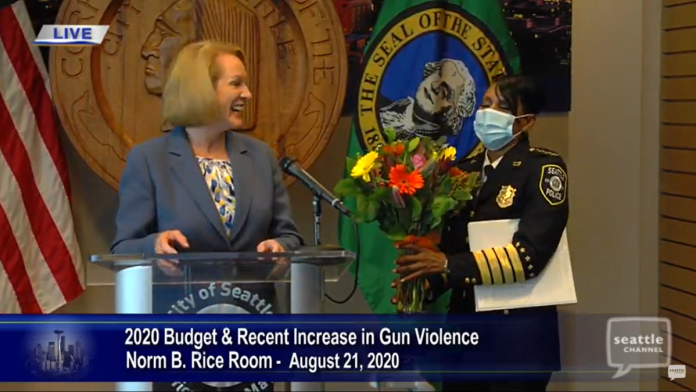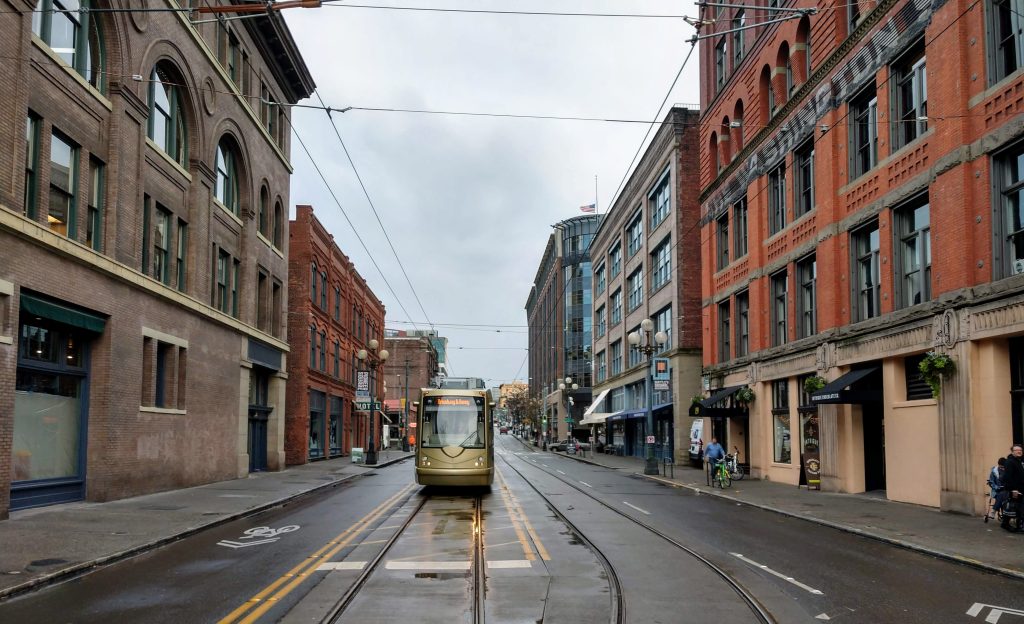
Every December, Mayor Jenny Durkan releases a list of accomplishments from the year, putting a positive spin on another year of her administration. This year’s report came out the same week as her announcement of not seeking a second term. The second announcement betrayed the truth of the first: Durkan has led a failed administration. Spin-filled year-end reports can’t hide the fact the last three years have been tumultuous and rudderless, nor the fact that hugely successful mayors don’t leave their post in the midst of one of the biggest crises in city history. This is when leaders lead, which explains Durkan’s departure.
The Mayor tried to paint her exit from the mayoral race as a win for the city, saying she won’t be distracted by running for reelection and can focus on governing. Unfortunately, the Mayor didn’t have the distraction of an election-year the past three years, and it didn’t seem to help. One exception to the Mayor’s general rule of delay and vacillating has been her relentless homeless sweeps; this morning Durkan is sweeping people from Cal Anderson Park homeless encampments one week before Christmas at the height of the pandemic. Advocates with Cancel Rent Washington and Democratic Socialists of America are mobilizing to protect people in the encampments and stop the sweep.
The last three years haven’t been easy. The last year alone has seen a pandemic, recession, out-of-control violent police departments, and a racial reckoning unseen since the Civil Rights Era. Colleen Echohawk, director of native-led human service nonprofit Chief Seattle Club, said it well: “She’s been handed a huge mess that no one knew was coming.” But Echohawk added the historic moment “required a response that maybe she wasn’t prepared for… we need a new way.”
While some challenges have been beyond her control, many are of her own making. Frequent, unrelenting homeless sweeps instead of meeting her campaign promise to build 1,000 tiny homes in her first year inflamed the problem. Rather than aiding efforts to add revenue for homelessness services and affordable housing–first with the 2018 head tax and then with the 2020 JumpStart corporate payroll tax–Durkan stood in the way out of deference to Amazon and the Seattle Metropolitan Chamber of Commerce. Those actions hang like a cloud over her record on homelessness, despite efforts to gussy up the narrative.
Transportation projects faced budget crunches in her term as they often do, but instead of swooping in to save the day, Mayor Durkan paused and canceled projects, throwing her predecessor under the delayed bus–and Mayor Ed Murray did run fast and loose with transit promises, planning, and accountability. While talking a big game about moving away from car dependency, the biggest projects to open in her tenure were car projects.
The failure to rein in SPD
When the murder of George Floyd happened and protests against police erupted, Mayor Durkan sided with police and property over the wellbeing of her residents. For weeks, she refused to say unequivocally that officers must display their identification after many obscured them with tape, and she resisted calls to ban tear gas, escalating the violence and mistrust between protesters and police. That was a choice. And the whole neighborhood of Capitol Hill suffered from it, whether they were protesting or not, as clouds of tear gas seeped into apartment buildings. This month we learned the U.S. District Court ruled that the City violated a restraining order by continuing to tear gas this summer. What a sad legacy.
As her police department became increasingly belligerent and violent in crowd control settings, she largely covered for them or ignored it as they assaulted journalists and targeted medics, nurses, and legal observers during protests. When the City Council requested she begin out-of-order layoffs to target police officers with the worst records of misconduct, Mayor Durkan sided with the police guild to claim this was impossible and too much paperwork, and then vetoed the City Council’s rebalancing budget over the layoff issue to further insulate the Seattle Police Department (SPD).
As Mayor Durkan pointed to the police contract as to why she couldn’t do out-of-order layoffs or require more accountability out of cops that were running wild brutalizing protesters, she hinted at another failing. She had negotiated the latest police contract in 2018 with these cop-friendly protections in them. That contract weakened recently passed accountability measures required by the Consent Decree process, and it handed out generous back pay and raises while punting on the issue of runaway overtime spending, helping the police budget swell to $409 million–nearly 30% of the City’s general fund budget.

Mayor Durkan joked that she and Police Chief Carmen Best, facing mounting pressure and stress, had contemplated a Thelma and Louise moment where they would flee out into the desert in a convertible. That ended up being prescient, as Best resigned a few weeks later and Durkan announced her exit a few months later. Neither really grappled with the actions that were necessary to guide SPD and the city out of the sinkhole it’s in, favoring a soft exit to a tough reckoning.
Rather than rein in increasingly belligerent police and their bloated department budget, Mayor Durkan pledged $100 million to communities of color–hoping to change the conversation from police violence. The problem is that money was raided from existing equity-minded programs like JumpStart spending plan and an investment fund from the previous budget that used Mercer Megablock proceeds intended to make auctioning off public land more palatable. Furthermore, she handpicked the “Equitable Communities Task Force” to divvy out the money and faced serious criticism from Black leaders for this top-down approach that crowded out grassroots efforts from King County Equity Now’s Black Brilliance Project for participatory budgeting, which was already in progress.
Killing bike projects and delaying transit
Durkan took over at a sensitive time for transportation, as the city prepared to open a number of major projects, including the SR-99 tunnel, that necessitated a temporary highway closure bringing many to predict “Viadoom” and the City to warn of a “Seattle Squeeze.” Instead of taking the Alaskan Way Viaduct closure as an opportunity to emphasize transit in a lasting way, the Durkan administration did the bare minimum and unabashedly celebrated the massive car tunnel despite the climate implications. Instead of swift action to roll out bus lanes and bike lanes, we got a former general defense contractor hired as traffic czar to do God knows what for a cushy salary.
She oversaw Seattle’s seven planned RapidRide bus line additions being strangled down to just two and a half, all of which are massively delayed. Despite existing plans calling for four new RapidRides to open during her first term, none will actually open under Durkan’s watch after the RapidRide H (upgrading Delridge’s Route 120) was recently delayed to 2022. The RapidRide G went from an initial 2019 target to 2024, the J from 2021 to 2025 at best in an shortened form terminating at U District Station, and the R went from 2021 to being in limbo due a budget shortfall. It’s been carnage. Covid and the Trump administration’s obstruction has been part of it, but the Mayor’s indecisiveness and unwillingness to step in with fixes is also to blame.
Instead of stepping to replace lost car tab revenue from the narrow passage of Tim Eyman Initiative 976, she proposed a transportation benefit district transit measure that made no such effort and slashed bus service. That forced Tammy Morales to lead on the issue with an amendment to double the Mayor’s proposal–later bargained down to a 50% boost. Despite fears that Prop 1 was in jeopardy, it passed with a whopping 80% of the vote in November.
Her record on biking is also abysmal. Shamelessly she canceled the 35th Avenue NE protected bike lane and street safety upgrades after an agonizingly long delay because of a few noisy opponents who made a stink and even set off fireworks to sabotage construction equipment. Bike lanes on N 40th Street were axed, while other plans, such as 4th Avenue, saw significant delays and many others were watered down. The Mayor proposed cutting $21.5 million from bike and pedestrian projects in her last budget. Advocates had to constantly fight just for information let alone actual progress on plans, which led to the formation of the Move All Seattle Sustainably (MASS) coalition.

And don’t even get me started on the streetcar. Mayor Durkan just couldn’t make up her mind on the Center City Connector, and did the project lasting damage by contributing to false narratives that it didn’t fit the tracks or other ridiculous stories that conservatives glom on to and will surely trot out when we try to revive the project. This highly valuable project would connect Seattle’s two disconnected streetcars and would take the system to a projected 20,000 daily riders shortly after opening, fulfilling promises to diverse neighborhoods First Hill, Yesler Terrace, and Chinatown-International District. It’s a game changer, but Durkan treated it like a white elephant gift she could wait to dispose of.
Even things held up as Durkan wins on transportation are fairly hollow.
The Fare Share Plan was a significant step forward in holding ridehailing companies accountable to employees and to the congestion they contribute to in cities. Before that plan could start collecting revenue, the pandemic hit meaning the 51-cent hike to the ridehailing tax collected almost no money in 2020 as ridehailing trips plummeted below an unfortunately high threshold (in retrospect) for companies to trigger the tax. So instead of saving the streetcar, the ridehailing tax is going to basically going to tread water on existing priorities for the foreseeable future.
The Stay Healthy Streets program has been promising reaction to the pandemic, but it was slow out of the gates and it still hasn’t been expanded to the densest parts of the city or much at all beyond its initial 20 miles. Despite a welcome announcement of intent to make those 20 miles permanent, the Mayor hasn’t funded the idea, and the City’s latest idea to find the money by cutting other bike projects is troubling. Ecology block barriers that could be making people walking, rolling, and biking on Stay Healthy Streets have instead been dedicated to turning East Precinct into a fortress. And the Mayor has refused to intervene to make the most popular open street, Lake Washington Boulevard, permanent which has denied this crucial route during winter months. Without more permanent deterrence for cars, Stay Healthy Streets have been plagued with smashed or tampered with signs and speeding motorists jeopardizing the safety of other street users.
Being a climate mayor, as she has attempted to style herself, requires just the kind of boldness that has been lacking; so, emissions continue to climb despite a climate action plan calling for sharp decreases. The Mayor announced a plan to pursue road congestion pricing, but never followed through. She expressed interest in 15-minute cities, but not in making the tough decisions to realize those lofty aspirations. It’s difficult to point to anything and say ‘yes Mayor Durkan knocked that out of the park.’
So while the Mayor claims she would win reelection if she ran, that braggadocio is not earned. Her decision to step aside was the wisest of her entire term.
Update: I added a paragraph about the $100 million pledge to communities of color, a sentence about being a climate mayor, and a comment about Mayor Murray’s record on transit.
Doug Trumm is publisher of The Urbanist. An Urbanist writer since 2015, he dreams of pedestrianizing streets, blanketing the city in bus lanes, and unleashing a mass timber building spree to end the affordable housing shortage and avert our coming climate catastrophe. He graduated from the Evans School of Public Policy and Governance at the University of Washington in 2019. He lives in East Fremont and loves to explore the city on his bike.


